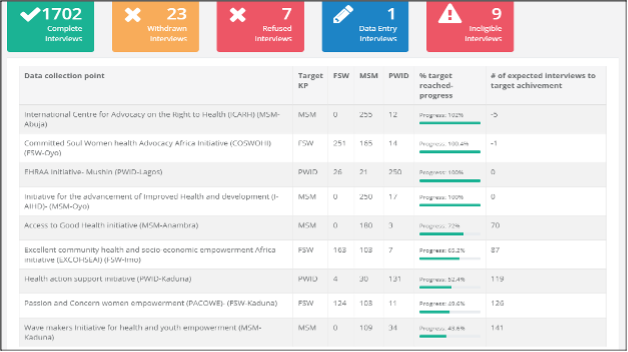BBS/KP Size Estimate
In 2019, Ciheb conducted the Game of Contacts Key Population Survey in the Nigerian states of Anambra, Imo, Oyo, Kaduna, Lagos, and the Federal Capital Territory. The survey was designed to measure the social visibility of key populations in the NAIIS 2019 Network Scaleup Model (NSUM) population size estimates.
The survey followed the following procedure:
· A random sample of first names (mixture of common and uncommon) from NAIIS is drawn.
· Participants are shown 24 names (12 male and 12 female) and asked if they know each person and if they are a member of the key population.
· Data from the survey is analyzed to produce a social visibility factor.
· The social visibility factor is applied directly to the NSUM population size estimates to provide more accurate data on key populations.

Solutions:
Mobile Application: In collaboration with partners, Ciheb developed a mobile app using CSPro that streamlined the data collection process. Team leaders collected and uploaded questionnaire data onto tablets, which were then securely synced to the central server as encrypted files via FTP
Data Processing Service: Ciheb developed a data processing solution that processed all transmitted files into JSON files using their data dictionaries and indexed them into an Elasticsearch database, which is a search engine that allows for fast and efficient search and analysis of large volumes of data. By indexing the data into Elasticsearch, the solution enabled users to quickly search and retrieve the data they needed.
Realtime Monitoring Dashboard: Ciheb developed a real-time monitoring dashboard using ASP .NET that interfaced with the data processing solution. The dashboard presented data in an intuitive and user-friendly manner, with charts, graphs, and other visual aids providing easy-to-understand insights into survey progress and data quality. This enabled data monitors to promptly identify and address data issues and stakeholders to monitor survey progress.
In addition, the dashboard tracked progress levels by key population typology and location, identifying areas that needed additional attention. By providing real-time access to data, the dashboard enabled stakeholders to monitor survey progress and identify challenges that required attention. Overall, the dashboard played a crucial role in ensuring the success of the survey by providing a comprehensive overview of data quality and progress.

During the development of the survey data system, an agile software development methodology was employed to ensure that the project was completed within the specified timeframe and budget. This methodology enabled the project team to develop different versions of the system in sprints, with testing and bug fixes incorporated into each iteration. The agile approach allowed for flexibility and responsiveness to changing project requirements and ensured that the system met the needs of the stakeholders.
The survey data system architecture was based on a de-normalized schema, which was carefully designed to allow for easy modification of the survey questionnaires. This made it possible to add or modify survey questions without disrupting the existing database structure. The de-normalized schema was also optimized for data retrieval, enabling users to quickly and easily retrieve the data they needed.
In addition to the de-normalized schema, the survey data system utilized a variety of technologies to ensure efficient data processing and analysis. The system made use of CSPro for mobile data collection, elastic search for data indexing and search, and ASP.NET for the real-time monitoring dashboard. These technologies were carefully selected to ensure that the system was robust, efficient, and scalable.
The agile development methodology and the use of advanced technologies allowed the project team to complete the survey data system on time and within budget while also ensuring that the system was of high quality and met the needs of the stakeholders. The system played a crucial role in ensuring the success of the survey by providing real-time access to data and enabling stakeholders to monitor survey progress and identify challenges that required attention.


